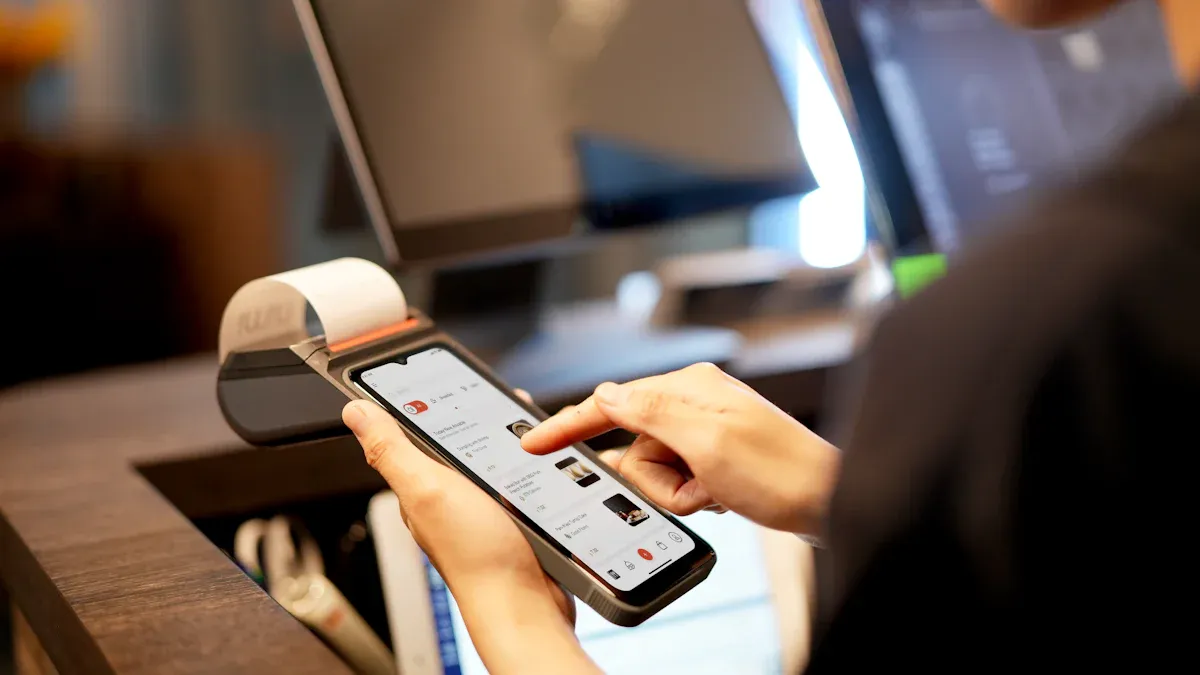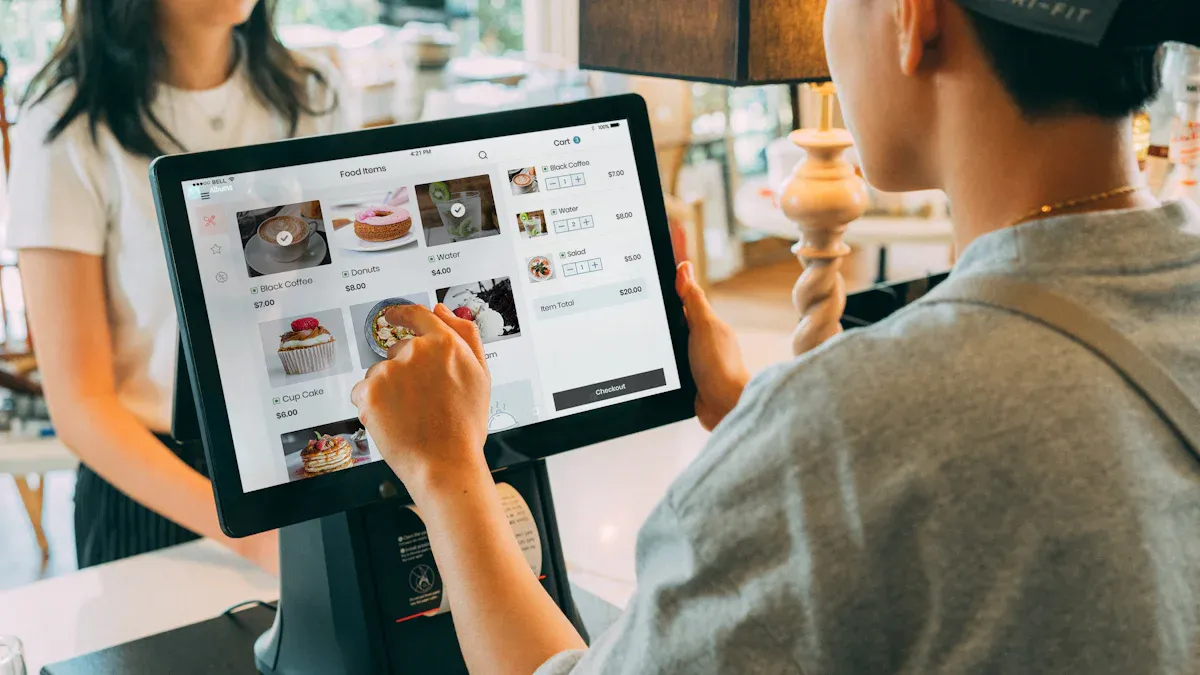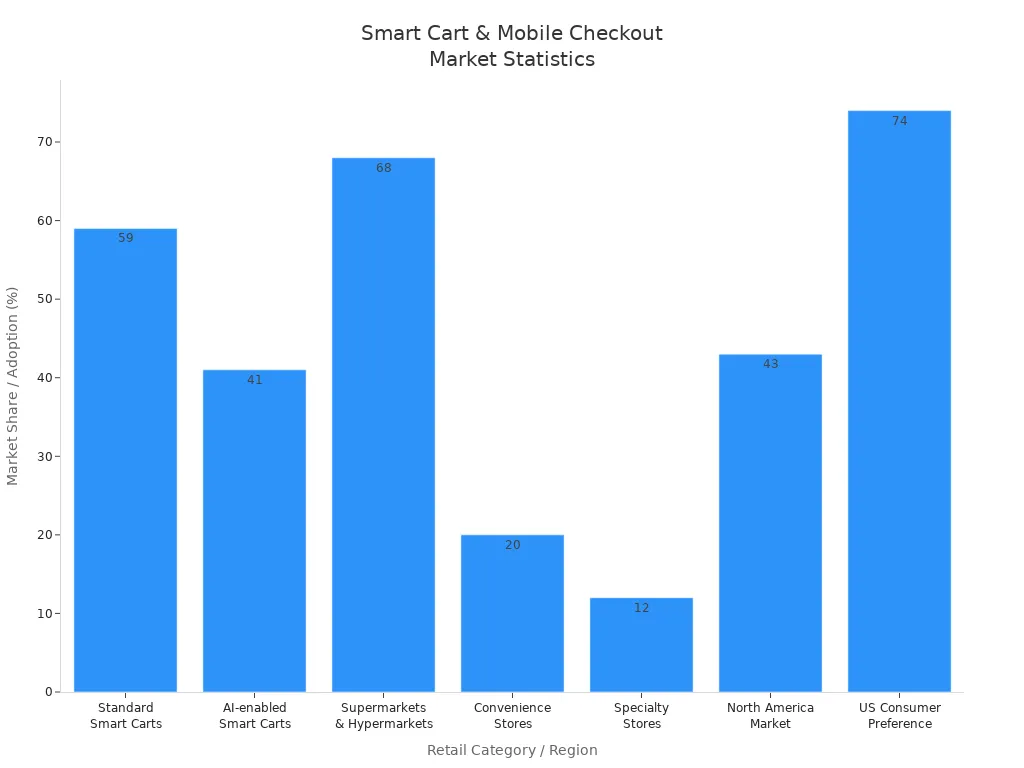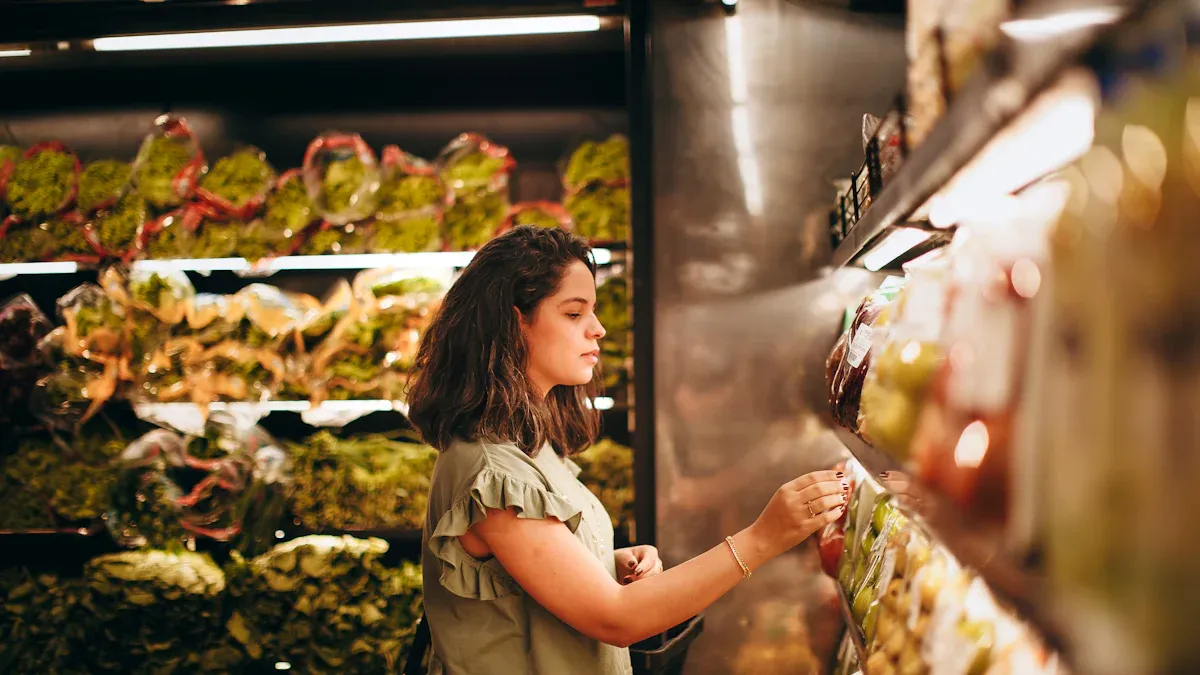Experts Reveal Breakthroughs in Automated Checkout for Modern Retail

Experts discuss significant changes in automated checkout systems, which are driving retail innovation and transforming stores worldwide. New ideas in retail focus on technology that enhances the shopping experience, making it faster and easier for consumers.
In June 2023, U.S. stores implemented more self-checkout lanes as part of their retail innovation strategy, responding to the demand for quicker shopping experiences.
Nearly 60% of shoppers in North America prefer self-checkout, indicating a growing trend towards automation in retail.
The self-checkout market is expanding globally, with contactless shopping gaining popularity as a key aspect of retail innovation.
Aspect | Impact |
|---|---|
Efficiency | Self-service checkouts reduce wait times, allowing staff to focus on other tasks. |
Customer Experience | Automation provides shoppers with quick and personalized service. |
Competitive Advantage | Retailers leverage data from automated systems to enhance operations and retain customers. |
Key Takeaways
Automated checkout systems make shopping better by cutting wait times and making customers happier. Self-checkout is liked by almost 60% of shoppers in North America. This shows that more stores are using automation. AI and edge technology help make payments easier and faster for stores and shoppers. Smart carts and mobile solutions are becoming more popular. These let shoppers skip lines and have a better time. Stores that use automated systems can use data to work better, keep customers coming back, and sell more.
Retail Innovation in Automated Checkout

Retail innovation is changing how stores handle checkout. Many stores now use automated checkout systems. These systems help make shopping faster and keep customers happy. Mishra et al. (2021) found that self-checkout systems make customers more satisfied and loyal. Stores think these changes are important to stay ahead and meet what shoppers want.
AI and Edge Technology Advances
Artificial intelligence and edge technology are important for automated checkout. Edge computing lets stores process payments right at the store. This makes checkout faster and easier for shoppers. Self-checkout kiosks and smart POS systems use this technology to speed up payments. AI systems can see what products you have without scanning barcodes. This makes checkout quicker and more accurate. Machine learning and computer vision help these systems spot items fast and record purchases right away. Edge AI helps stores connect in-person and online shopping. This gives customers real-time service and helps stores work better.
Tip: Stores that use AI and edge technology often work better and have happier customers.
Smart Carts and Mobile Solutions
Smart carts and mobile checkout are becoming more common in big stores. These tools help shoppers skip lines and pay easily. The table below shows some facts about how stores use them:
Category | Statistic/Insight |
|---|---|
Consumer Demand | 69% of shoppers want easy, line-free checkouts. |
Small Retailers' Concerns | 61% say high costs make it hard to use these tools. |
Standard Smart Carts Market | 59% market share, cutting wait times by 37%. |
AI-enabled Smart Carts Market | 41% market share, raising basket value by 29%. |
Supermarkets & Hypermarkets | 68% market share, needing 33% fewer cashiers. |
Convenience Stores Adoption | 20% use them, with 21% more repeat shoppers. |
Specialty Stores Performance | 12% market share, selling 34% more extra items. |
North America Market Share | 43% share, with 75% of big stores using smart carts. |
US Consumer Preference | 74% like self-service checkout. |
Average Basket Size Increase | Early users see 29% bigger baskets than with old carts. |

Retail innovation helps stores use these new tools. This cuts down wait times and makes shopping better. As more stores use smart carts and mobile checkout, customers get faster checkouts and more convenience.
Autonomous Checkout Systems and Cashierless Trends
Autonomous checkout systems have changed how people shop today. These systems use new technology to make shopping quick and safe. Stores use autonomous solutions so customers do not wait in line. Many stores have seen more sales and happier shoppers.
Computer Vision and Sensor Fusion
Computer vision and sensor fusion are important for autonomous checkout. Cameras and sensors work together to watch products and shoppers. These tools help stores know what items people pick up or put back. Real-time tracking keeps shelves full and stops loss. Autonomous checkout uses artificial intelligence to spot items and record sales fast.
Here are some benefits of computer vision and sensor fusion in autonomous checkout systems:
Cashier-less shopping lets people leave without stopping at a register.
Real-time tracking helps stores know what sells.
Easy customer interactions make shopping simple.
Less shrinkage means less stealing and loss.
More sales happen when more people buy.
Faster service lets stores help more shoppers.
Quick ROI means stores get money back sooner.
No lines give shoppers more time in the store.
More sales per space means stores sell more in less room.
Bigger baskets happen when shoppers stay longer.
Better experiences make people want to return.
Loss prevention keeps stores safe.
Autonomous checkout uses computer vision to watch for theft. IoT sensors track items and update stock. Blockchain keeps data safe and private. Agentic AI finds fraud and warns staff. Facial recognition controls who enters and pays. Smart alerts tell staff about theft right away.
Security Enhancement | Description |
|---|---|
Computer Vision | Uses cameras and smart software to watch the store, spot theft, and track products. |
IoT Sensors | Watches items picked up or put back, updates stock in real-time, and uses RFID tags for tracking. |
Blockchain | Keeps data safe and secure with cryptography, stops changes, and helps with safe transactions. |
Agentic AI | Spots fraud, watches for strange actions, and gives alerts and reports for security. |
Facial Recognition | Controls who comes in and pays, making stores safer from unwanted people. |
Smart Alerts | Sends quick warnings about theft with smart systems and shelves. |
Stores use these tools to keep autonomous checkout safe. Autonomous technology helps stop theft and fraud. Stores lose less and have better control over their products.
Cashierless Checkout Models
Cashierless checkout models let shoppers pay without help from workers. Autonomous checkout uses artificial intelligence and sensors to track what people buy. These models help stores serve more people with fewer workers. Autonomous checkout makes shopping faster and easier.
Here are some big changes in autonomous checkout systems:
Amazon Go started cashierless shopping and made checkout quick.
Walmart used artificial intelligence to make checkout faster and cut loss by 15%.
Target added fast self-checkout lanes for speed and safety.
Sam's Club saw basket size grow by 27% with Scan & Go.
Aldi used Grabango tech to lower worker costs by 20%.
Kroger made customers happier by 30% with smart carts.
Retailer | Breakthrough Description | Impact |
|---|---|---|
Sam's Club | Scan & Go app users had baskets 27% bigger | More sales for the store |
Aldi | Grabango tech cut worker costs by 20% | Faster checkout for shoppers |
Kroger | Smart carts made customers 30% happier | Transaction value went up by 12% |
Autonomous checkout helps stores handle more sales. Automation cuts mistakes and makes checkout more reliable. Stores do not need more workers to help more shoppers. Autonomous checkout creates a standard way for everyone.
Here is how cashierless checkout models help stores:
Autonomous checkout cuts wait times and makes shopping fun.
Shoppers feel happier and come back more.
Automation lets stores help more people without more workers.
Stores save money and work better.
Scalability and cost are important for autonomous checkout. Some stores have problems with cashierless models. Walmart stopped Scan & Go after four months because few used it and there was theft. Big stores need strong anti-theft tools for autonomous checkout. Amazon Go spent over $1 million on hardware for fully autonomous stores. Many stores think these systems cost a lot to start.
Autonomous checkout keeps growing. Stores use new technology to make shopping quick and safe. Autonomous solutions help stores stay ahead and give shoppers a better experience.
Overcoming Challenges in Automated Checkout
User Experience and Accessibility
Retailers have problems when they start using automated checkout. Many shoppers wait a long time at self-checkout. Some stores pay a lot and need to train workers. Small and medium stores find it hard to use many new tools. They must plan well and connect systems in all parts of the store.
Stores use new ideas to help shoppers. Some use smartphone and web tools for people who cannot see well. Real-time help, image reading, and talking features make checkout easier. A web page lets users send pictures of screens and get voice help. Stores also think about screen size, height, and if screen readers work. They follow the Americans with Disabilities Act and other rules. This helps all shoppers use automated checkout.
Note: Making checkout easy for everyone makes shoppers happy and loyal.
Security and Theft Prevention
Security is a big worry for automated checkout. Stores see more theft and new tricks like barcode switching and fake payment moves. Retailers use many ways to stop loss and work better.
Theft Technique | Description |
|---|---|
Barcode switching | Putting a cheap item's barcode on an expensive one to pay less. |
Partial scanning or 'pass around' | Not scanning every item, pretending to scan, or hiding items. |
Fake swipe payment trick | Pretending to swipe a card but not really paying. |
Stores put in weight sensors and smart cameras to watch sales. These tools find strange actions and tell workers. Staff watch self-checkout areas to help and stop theft. Stores also use signs and announcements to warn shoppers. AI cameras can cut theft by up to 90% with fast checks. Weight and barcode checks find mistakes and help stores work faster.
Data Privacy and Compliance
Automated checkout must follow strict privacy laws. Rules like GDPR and CCPA say stores must protect customer data. Automation helps stores answer requests to see or delete data fast.
Evidence | Description |
|---|---|
Data Privacy for Retail & E-Commerce Companies | Stores must let shoppers see or delete their data and keep it safe. Automation helps handle these requests and keeps stores from getting fined. |
Automated Data Security and Compliance for the Retail Industry | GDPR and CCPA have rules for data that automated systems help stores follow. |
A Quick Guide on CCPA and GDPR Data Minimization Essentials | Stores should only collect the data they need to lower the risk of data leaks, which is important for GDPR and CCPA. |
CCPA vs GDPR: key differences and similarities | Both GDPR and CCPA set rules for how stores collect, use, and share data, and automated systems must follow these rules. |
Stores collect less personal data to lower risks. Automated checkout helps stores follow the law and keep data safe. These steps help shoppers trust stores and make work easier.
Case Studies: Retailers Leading the Way
Uniqlo’s Self-Checkout Innovation
Uniqlo is a leader in self-checkout. The company started using RFID technology almost ten years ago. At first, Uniqlo used RFID to help with supply chain work. When RFID became cheaper, Uniqlo put it in stores. Now, shoppers can check out much faster.
Uniqlo’s self-checkout kiosks let customers drop items into bins. The system reads the RFID tags on each product. This means no one has to scan items by hand. Store workers spend less time at the register. They can help shoppers more. Inventory is easier to track and more correct.
Innovation | Description | Impact on Store Operations |
|---|---|---|
RFID Technology | Automated checkout uses RFID tags on items. | Streamlines inventory and improves customer experience. |
Self-Checkout Machines | Shoppers drop goods in bins at automated checkout stations. | Reduces manual scanning and boosts efficiency. |
Uniqlo’s way shows self-checkout can make stores faster and more accurate.
Other Retailer Success Stories
Many stores use self-checkout to work better. 7-Eleven added self-checkout kiosks. This made lines shorter and let 15% more people check out. Tesco and Aldi added contactless features after the pandemic. These changes made self-checkout use go up by 10-20%.
Target used mobile self-checkout units when stores were busy. Lines got 25% shorter. Best Buy used self-checkout for returns. This made returns faster and made customers happier.
Aldi Shop&Go opened stores with no checkout lines. Customers shop and pay with a phone app.
Amazon Go made stores with 'Just Walk Out' technology. Customer service got 300% better. Yearly sales went up by 56%.
Stores keep spending money on self-checkout. These new ideas help stores serve more people and give better shopping experiences.
Impact on Customer Experience and Retailers

Efficiency and Personalization
Automated retail has changed how stores help shoppers. Many stores use automated checkout tech to make checkout faster. Shoppers wait less and have more control over shopping. For example, 57% of shoppers like Amazon Go’s cashierless system. Walmart uses AI to lower inventory loss by 15%. Aldi’s Grabango tech cuts labor costs by 20%. Sam’s Club’s scan-and-go makes basket size 27% bigger. These facts show stores are more efficient and accurate.
Automated retail also gives more personalization. AI-driven systems use customer data to make shopping more fun. Shoppers get offers that fit their needs. Stores use scan-and-go tech so shoppers can check out fast. Payment is easy and smooth. This makes customers happier and more satisfied.
A table below shows how checkout affects loyalty:
Finding | Description |
|---|---|
Customer Loyalty | Regular checkout makes shoppers more loyal than self-checkout. |
Mediating Factors | Saving effort and feeling special affect loyalty. |
Moderating Factors | Bigger baskets mean more loyalty for regular checkout. |
Rewarding Experience | If self-checkout feels good, loyalty is the same as regular checkout. |
Automated retail makes checkout faster and more personal. Shoppers feel in charge and enjoy more convenience.
Omnichannel Integration
Automated retail helps stores connect online and in-store shopping. Stores use automated checkout tech for this. Self-checkout kiosks let shoppers scan, bag, and pay alone. Walmart’s self-checkout stations help stores during busy times.
Key features of automated retail are:
Payment systems that take many payment types.
Inventory updates in real time after each sale.
Screens that can show store brands and ads.
Tools to stop theft and mistakes.
Automated retail uses payment systems and scan-and-go tech for easy checkout. Shoppers get a smooth and easy shopping trip. Stores see better accuracy and more sales. Automated retail helps stores stay ahead and give better service.
Note: Automated retail makes checkout better for everyone, so shopping is easier and more fun.
The Future of Cashierless Retail
Emerging Trends and Research
Retailers notice new trends are shaping cashierless checkout. AI-powered personalization is a big change. Stores use artificial intelligence to suggest items and update digital signs. They also run smart loyalty programs with this technology. Hybrid shopping models are getting more popular. Many stores now have scan-and-go checkouts and smart carts. These choices let shoppers pick how to pay and move in the store.
Biometric and digital payments are used more often now. Some stores use facial recognition or palm scanning for faster, safer payments. Research shows technology is making stores smarter. Shoppers like cashierless checkout because it is quick and easy. But some people worry about privacy. More research is needed to see if people trust fully automated stores.
Note: Intelligent unmanned convenience stores are spreading around the world. Different places accept these changes at different speeds.
Recent studies say cashierless checkout systems will grow a lot. The table below shows what experts think will happen:
Market Segment | Projected Growth (2024-2032) | CAGR (%) |
|---|---|---|
Autonomous Checkout | 10.3% | |
Self-checkout System | USD 5,612M to USD 14,307M | 14.5% |
Expert Predictions
Experts think cashierless retail will soon be normal. They believe more stores will use cashierless checkout as tech gets better. Experts also think inventory robots, self-driving delivery cars, and drones will help stores work better.
Many experts say cashierless checkout will change how stores operate. Amazon Go stores have inspired others like Sam’s Club, Walmart, and Kroger to try these ideas. Retailers are getting ready by building strong software and using AI-driven self-checkout with computer vision. They also try to fix privacy and hardware problems.
Tip: Stores that start using cashierless checkout now may lead the market as these trends grow.
Experts say automated checkout is changing how we shop. Stores use self-service kiosks and smart shelves to help shoppers. These tools make shopping faster and easier for everyone. People wait less in line and get better service. Stores can also make more money with these systems. Retailers use data to find out what shoppers like. They change what they sell and how they advertise. AI gives shoppers personal tips and helps with questions using virtual assistants. Soon, there will be more stores without cashiers. Stores will track items better and move products faster. Shoppers and stores should get ready for more changes as technology keeps growing.
FAQ
What is automated checkout in retail?
Automated checkout lets shoppers pay without a cashier’s help. Stores use machines and sensors to make checkout faster. This technology helps people spend less time waiting. It makes shopping better for everyone.
How do scan-and-go systems work?
Scan-and-go systems let shoppers scan items with a phone or device. After scanning, they pay at a kiosk or with an app. This makes checkout quick and simple.
Are automated checkout systems safe for customer data?
Stores keep customer data safe with secure software. They follow privacy laws and use encryption. Automated checkout does not collect too much information. Shoppers can trust their data is protected.
What are the main benefits of automated checkout for customers?
Benefit | Description |
|---|---|
Speed | Checkout is fast for shoppers. |
Convenience | Shoppers control their own checkout. |
Fewer Lines | People wait less in line. |
Can small stores use automated checkout?
Small stores can use automated checkout, but it may cost more. Many pick simple systems like self-checkout kiosks. These help small stores save time and serve shoppers better.
Tip: Stores should teach workers to help shoppers use new checkout systems.
See Also
The Transformation Journey of Self-Checkout Systems
Analyzing Walgreens Self-Checkout: Benefits and Hurdles in Shopping
Walmart Self-Checkout Updates: Anticipated Changes for 2025
The Impact of Smart Technology on Vending Machines in Retail
